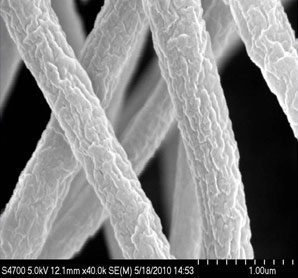 |
| Fonte: aqui |
The announcement explained nanometers. For perspective, a human hair is about 100,000 nanometers wide. Materials at this scale have unique properties. Cellulosic nanomaterial has exceptional strength and considerably lighter weight when compared with materials it can replace. It is lower cost than similar nanomaterial and it is made from a renewable resource. Potential applications include ballistic glass replacements, body armor, auto and aerospace structural materials, flexible electronic circuits, solar panels and more.
"This public-private partnership will develop high-tech outputs from the forest products sector, and promote the invention of renewable products that have substantial environmental benefits," said Vilsack.
The three-year partnership will promote cellulosic nanomaterial as a commercially viable enterprise by building on work done by the Forest Products Laboratory in Madison, Wis. The partnership seeks to overcome technical barriers to large- scale wood-based nanotechnology processing, while filling gaps in the science and technology that are needed for commercialization. Initial funding comes from the Endowment and the Forest Service. The partnership is currently seeking additional public and private sector funding.
USDA, the Endowment, and the Forest Service have previously collaborated on numerous ventures: the potential of biotechnology to address forest health; technical advice given to African American forest landowners; and wood-to-energy projects that support the growth of jobs in rural America.
Together with partners, this new venture will:
- Emphasize the potential of wood- based nanotechnology for the economy and the environment.
- Overcome technical barriers to commercialization of wood- based nanotechnology.
- Demonstrate commitment to creating high paying jobs in rural America through value- added manufacturing and high value products.
- Showcase the commitment of USDA and the Forest Service to innovation.
Even with the nanometers explanation and the new venture goals, the eventual products that might be produced are not referenced. The public has to take it for granted that this research will result in real products
Fonte: AG-Professional
